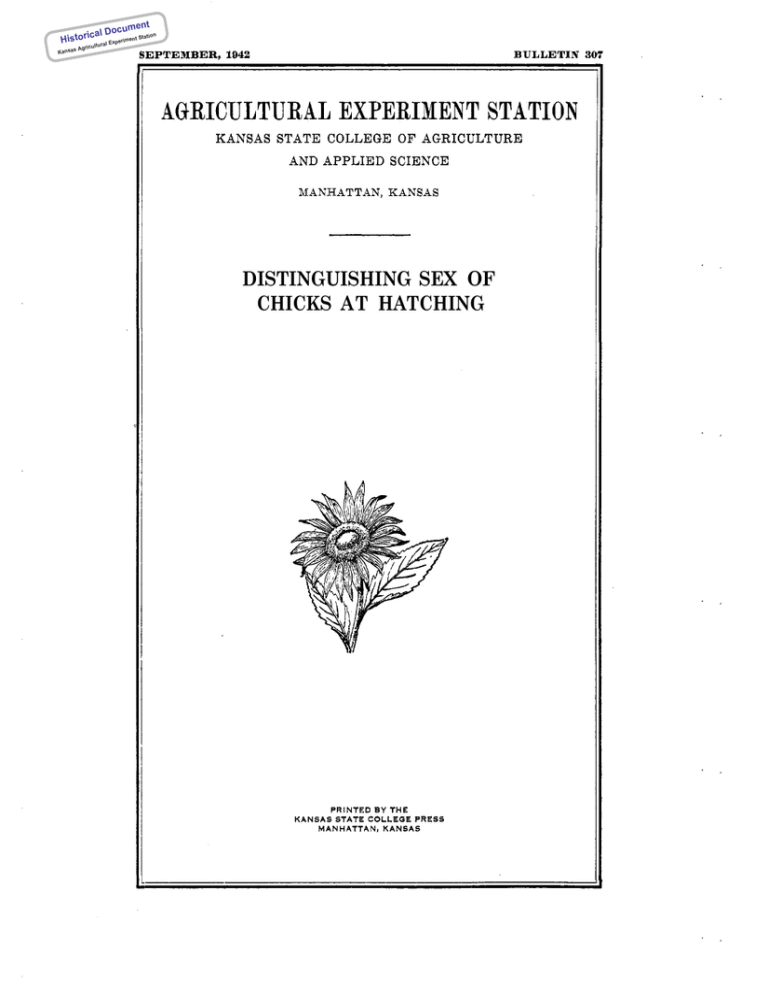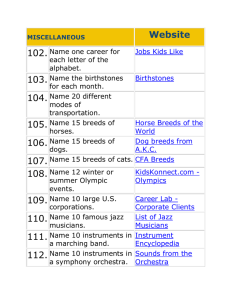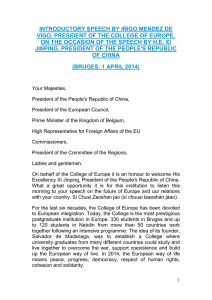
t
cumen n
io
cal Do
Histori tural Experiment Stat
Kansas
Agricul
DISTINGUISHING SEX OF
CHICKS AT HATCHING
t
cumen n
io
cal Do
Histori tural Experiment Stat
Kansas
Agricul
t
cumen n
io
cal Do
Histori tural Experiment Stat
ul
Agric
Kansas
DISTINGUISHING SEX OF CHICK AT HATCHING ¹
D. C. Warren
NEED FOR METHODS
The need for a method of identifying the sexes of poultry at
hatching has long been felt. In most other animals there are
external characteristics that make the sexes readily distinguishable. However, in the chicken there are no easily recognized
marks for sex until it is at least a few weeks old. With the development of the hatchery industry, this need has been emphasized.
Due to the specialization in the industry, there is a demand for
chicks of one sex. If the poultryman who buys chicks primarily
for replenishing his supply of layers can be guaranteed 100 percent females, his facilities for brooding may be reduced by half.
In certain regions during the late season the males are reared
at a loss, so that it would be more profitable to kill them at
hatching. The broiler industry is becoming an important phase
of poultry husbandry, and since it is known that males grow
more rapidly than females they are quite acceptable to this
branch of the industry. Capon producers are also glad to be
able to purchase male chicks exclusively.
The first method of sex identification in day-old chicks to be
used commercially was that utilizing sex-linkage in crossbreds.
Punnett (1919) listed crosses in which the sex in the offspring
could be recognized by down color. Some years later the socalled Japanese or vent method of sex identification came into
use.
VIGOR OF CROSSBREDS2
The exceptional sturdiness of first generation crossbred animals has long been recognized by breeders of livestock, and the
practice of keeping such crossbreds is common. In the past
decade there has been an increased utilization of crossbred
poultry. In general it can be said that any stimulation derived
from the crossing of breeds and varieties of poultry is confined
to the first generation. The use of crossbreds themselves as
breeders is not to be encouraged. Most of the methods of identification of sex at hatching have involved crossing of breeds and
varieties of chickens.
Considerable data have been accumulated in the past few
years for the comparison of the vigor of crossbred and purebred
poultry. Data obtained at the Kansas Agricultural Experiment
Station are presented in Table 1. This table carries data obtained in five different years and four different crosses. For each
year results were available from reciprocal crosses between the
two breeds
involved. Data are given on chick and adult mor.~
t
cumen n
io
cal Do
Histori tural Experiment Stat
Kansas
Agricul
tality; chick growth; age at sexual maturity; egg and adult
weight; and egg production. Different strains of the same
breeds are seen to vary greatly in the characteristics used as a
measure of vigor.
As a whole, the data in Table 1 support the view that crossbreeding stimulates the vigor of the resulting offspring. In
many instances the stimulation is not great but the cumulative
gains from consideration of all characteristics are of economic
significance. There is considerable variability in the results of
crossbreeding but in many instances there is a tendency to combine in crossbreds the more desirable characteristics of the two
breeds utilized. The reciprocal matings show wide differences
with respect to some characteristics. Comparing roughly the
data for reciprocal matings and considering the results as a
whole it will be seen that in a large majority of the comparisons
the crossbreds were equal to or better than the superior of the
two parent stocks.
t
cumen n
io
cal Do
Histori tural Experiment Stat
Kansas
Agricul
It is seen that not all crossbreds are superior to purebreds but
in general their sturdiness ranks them above the purebreds used
in the study. It is evident that there is a reflection in their offspring of the qualities of the purebreds used in the production
of the crossbreds. Crossbreds appeal most to those poultrymen
who have no breeding program of their own but depend upon
the hatcheryman for the replenishment of their stock. Crossbreds are extensively used by broiler producers who find the
high viability and uniform growth a valuable asset. So in addition to the advantage of being able to identify sex at hatching
in some crossbreds, their vigor is also a recommendation for
them.
POPULARITY OF CROSSBREDS
The writer contacted through a questionnaire 52 hatcherymen who were selling crossbred chicks, to learn the crosses
which were proving most popular. About half the replies came
from Kansas hatcherymen and the rest from other states. Each
hatcheryman was asked to name his three most popular crosses
in order of their popularity and to list all the crosses he was
making. In each rating the commonly called Austra-Whites,
resulting from the mating of the Australorp male with the
White Leghorn female, out-ranked all others. Thirty-five of
the reporting hatcherymen listed this cross and 31 ranked it as
their most popular crossbred. Other popular crosses were reciprocal matings between Barred Plymouth Rocks and Rhode
Island Reds and between White Plymouth Rocks and White
Leghorns. The Black Minorca male mated to White Leghorn
females was also a popular cross. In many of the more popular
crosses including that producing the Austra-Whites sex cannot
be identified at hatching except by the Japanese method.
SEX IDENTIFICATION IN PUREBREDS
BARRED PLYMOUTH ROCKS
It had long been recognized that the size of the light head
spots in Barred Plymouth Rocks varied in the two sexes. The
males tend to have larger headspots and the females to have
darker colored legs. However, this method has not been sufficiently accurate to be of much commercial value.
Quinn and Knox (1939) attempted to separate the sexes of
Barred Plymouth Rocks by means of the intensity of the black
pigment in the down and legs. In different lots of chicks they
report 83.5, 86.1 and 91.8 percent accuracy.
Jerome (1939) describes a method of sex identification in
Barred Plymouth Rocks based upon the regularity of the outline
of the head spot rather than the size of the spot. Those chicks
having headspots irregular in outline and scattered in appearance are males while the females tend to have headspots with
t
cumen n
io
cal Do
Histori tural Experiment Stat
Kansas
Agricul
ument
c
cal Do
Histori
riment
pe
tural Ex
Agricul
Kansas
Station
more regular outlines. The author claimed an accuracy of 90
percent or better when considering only the headspot and 95
percent if the color of the legs was included in the consideration.
The Canadian Department of Agriculture (Anonymous 1941)
issues an excellently illustrated bulletin describing the method.
It is stated in the bulletin that the method “is widely practiced
in Barred Rock chicks by commercial chick sexers.” Sex identification is based upon outline of head spot, color of legs and
shade of down color. There are several types of male and female
head spots some of which are shown in Figure 1.
RHODE ISLAND REDS
Byerly and Quinn (1936) report that there is some sex difference in the down of Rhode Island Red chicks. The females
tend to show spots or stripes of darker color in the down on the
head and back. By separating the chicks into groups with and
without spots or stripes sex was identified with 82 percent
accuracy.
AUTOSEXING BREEDS
Punnett and Pease (1930) were the first to produce a breed
in which sex could be recognized with accuracy at hatching.
This breed, Cambar, was the result of crossing Barred Plymouth
Rocks and the Campine. The males have much lighter colored
heads than do the females. It is now known that this condition
can be brought about when bringing the barring factor into any
variety with brown striped down. Legbars are the result of
bringing the barring factor into Brown Leghorns.
Considerable interest is now expressed in these so-called
autosexing breeds and it is probable that various types will be
available in the next few years. The chief advantage of this
method of sex identification is that it requires no special crosses
when once the breed is established. When autosexing breeds
with economic characteristics equal to those of the well established breeds, are available, they will probably be accepted by
poultrymen. As yet, such autosexing breeds are not available.
FEATHERING STRAINS
The possibility of the use of rate of feathering as a basis of
sex identification was first called to attention by the writer
(1930). The method was first used for sex identification in dayold crossbred chicks and is more fully discussed under that heading later in this publication. However, in more recent years
the wing feathering method is being used extensively for sexing
day-old purebred chicks. The method is especially popular in
Canada at present. It requires the development of early and late
feathering strains of the breed being sexed. This may be done
either by selection or crossbreeding.
t
cumen n
io
cal Do
Histori tural Experiment Stat
Kansas
Agricul
Most of the larger breeds (other than Mediterraneans) are of
the sex-linked late feathering type. However, some early feathering chicks appear in these breeds and proper selection of them
makes possible the establishment of early feathering strains
of the larger breeds. In the case of most Mediterranean breeds
such as the White Leghorn it has been necessary to crossbreed
to bring late feathering into these breeds. Following this, careful selection and back crossing are practiced to reestablish the
other characteristics of the Leghorn breed. When both early
and late feathering strains are available in any breed, sexing is
possible by mating males from the early feathering strain to
females of the late feathering. From such a mating the males
will be late feathering and the females early feathering. Methods of identification of early and late feathering in day-old
chicks are described later in this bulletin.
Aside from their use in sexing there is considerable interest
in developing early feathering strains of the larger breeds in
order to avoid the problem of obtaining satisfactory feathering
in broilers and fryers. The “barebacks” occurring in males of
the larger breeds frequently are sources of considerable loss
when they are marketed. In many of the larger breeds early
feathering strains are being developed for the purpose of overcoming the broiler feathering problem. It is now known that
early feathering can be introduced into a breed without affecting any of its other economic characteristics.
t
cumen n
io
cal Do
Histori tural Experiment Stat
Kansas
Agricul
The procedure to be followed in developing early feathering
strains of the larger breeds is first to examine chicks of the
strain when they are from 9 to 12 days old and mark those
which have well developed tails, and wings approximately equal
to the length of the body. This will be the feathering typical of
most White Leghorns. Some strains of the large breeds will
have no early feathering chicks. If the early feathering chicks
are scarce in a strain, those marked are likely to be females. If
both male and female early feathering chicks are found and
later mated, their offspring will be pure for early feathering and
the strain will breed true for the characteristic thereafter.
If only early feathering female chicks are found they may be
mated to a male of their variety in order to obtain early feathering males. Their sons will be late feathering but if these sons
are mated to any early feathering females they will produce
some males and females which are early feathering.
Poultrymen interested in the production of early feathering
strains frequently do not recognize the necessity of examination of the chicks at 9 to 12 days of age. They have too often
relied upon one examination made at the broiler stage. Birds
showing good feathering at the broiler stage will not necessarily
breed true for good feathering. However, if only birds are mated
which have well developed tails at the 9- to 12-day age and
good feathering at the broiler age, the “bareback” problem will
be overcome. After one mating of this type only limited further
selection need be made unless new blood is introduced. If new
blood is to be brought in it should be done through females and
only their female offspring saved. Such female offspring will
be pure for early feathering provided their tails are well developed at ten days.
JAPENESE OR VENT METHOD
This method, probably first used by the Chinese was introduced into this country by the Japanese and thus gets its name.
It requires the examination of the vent or cloaca of the day-old
chick, in which slight anatomical differences are present in the
sexes. Due to the smallness of the vent at this age, the differences are detectable only by careful examination by an experienced operator. The skill in the technique is in knowing how
to make the proper application of pressure on the abdomen of
the chick for exposing the anatomical differences. Accuracy of
sex-identification and speed of operation come only after considerable practice. Accuracy is above 95 percent in skilled
sexers and this method is the one most widely used in the United
States.
SEX IDENTIFICATION IN CROSSBREDS (SEX-LINKED METHOD)
The possibility of the utilization of sex-linked characteristics in chickens for the identification of sex in day-old cross-
t
cumen n
io
cal Do
Histori tural Experiment Stat
Kansas
Agricul
breds was first called attention to by Punnett (1919) of England.
He recommended the utilization of down color and the writer
later suggested the use of rate of feathering characteristics for
the same purpose.
The four longer known characteristics of poultry which exhibit the sex-linked type of inheritance are gold and silver color,
barring and non-barring, slaty and non-slaty shank color, and
early and late chick feathering. Shank color is not sufficiently
well developed at hatching to be of value in sex identification.
The use of the other three characteristics for sex identification
in day-old crossbreds has become widespread in this country and
in Europe.
In the early development of crossbred poultry, the possibility
of sex identification was a factor in stimulating its use. With the
introduction of the Japanese method it might have been expected that their popularity would decline but this does not appear to
be true. The use of sex-linked characters for sex identification
places certain limitations as to breeds which may be used and
the manner in which they are crossed. Some hatcherymen are
overcoming the limitation by using the Japanese method for
sex identification in crossbreds. However, where sex-linked
characters can be used for identification of sex in chicks, the
method requires less expert knowledge than does the Japanese
method.
To give an example of sex-linked inheritance, if a Rhode
Island Red male is mated with a Light Brahma female, the female chicks will show various shades of buff- or red-colored
down and the male chicks will be white or smoky white, being
very similar to the chicks of standard-bred Light Brahmas. This
is a case of crisscross inheritance where the daughters show the
down color of the father and the sons that of the mother. As
adults the females are buff or red in color and the males will be
much like pure Light Brahmas. If the cross is made in the opposite direction, using the Light Brahma male, the chicks will all
resemble pure Light Brahmas and the sexes cannot be identified
at hatching.
GOLD-SILVER CROSS
Among the common breeds and varieties that carry the gold
factor and may be used as the sire in a cross are all buff varieties,
partridge pattern, gold laced, Brown Leghorn, and Rhode Island
Red. The breeds and varieties from which the females for a
cross may be chosen include all silvers, all Columbian varieties,
Light Brahmas, and White Wyandottes. Any cross of a male
from the gold group by a female from the silver group produces
offspring that show a different color pattern in the two sexes.
(Fig. 3) The gold females can be much more easily distinguished from the silver males if the Columbian pattern is involved. (Fig. 4) The breeds and varieties carrying this pattern
t
cumen n
io
cal Do
Histori tural Experiment Stat
Kansas
Agricul
t
cumen n
io
cal Do
Histori tural Experiment Stat
Kansas
Agricul
t
cumen n
io
cal Do
Histori tural Experiment Stat
Kansas
Agricul
are all buffs, Rhode Island Reds, Columbians, and Light
Brahmas. It does not matter from which side this pattern enters
the cross, but since it is a dominant character, most of the offspring will show its pattern. Chicks from such a cross have very
little pattern in the down and allow the difference between the
gold and silver to exhibit itself. As adults the males will show
the Columbian pattern and the females will be buffs or reds.
Where the Brown Leghorn male is crossed with laced or penciled
varieties, the broad brown down stripe covers so much of the
crossbred chick's back that the golds and silvers are not so easily
distinguished.
The most serious handicap to the use of the gold-silver cross
is that there are relatively few production-bred silver varieties
in America and the silver varieties are not especially popular.
On the male side one has the Rhode Island Red, the Brown
Leghorn, and all buff varieties, which supply an abundance of
well-bred birds of the one sex. The White Wyandotte, although in
the white group, is a recessive white and has usually been found
to carry silver. Difficulty arises, however, from the fact that the
white plumage makes it impossible to detect the individuals that
do not carry silver. Some White Wyandottes also carry black
and will throw many black chicks the sex of which cannot be
determined. Although these difficulties may be encountered in
using the White Wyandotte breed as a silver, it is here listed
because of its availability and production qualities. Many
strains of this breed when crossed to gold males will give good
crisscross inheritance, and when satisfactory strains can be
found the White Wyandotte probably will produce better crossbreds than most other silver breeds in America. Because of the
lack of satisfactory breeds, the gold-silver method has not been
widely used.
BARRED-NONBARRED CROSS
The cross which has been used more extensively than any
other in this country is the one in which the presence or absence
of the factor for barring has been the distinguishing feature. If
Barred Plymouth Rock females or the females of any breed
showing the Dominique pattern are mated to blacks or any breed
showing other patterns, the female chicks are uniformly black
or brownish black above and the males are black with a prominent light spot on top of the head. (Fig. 5) This head spot makes
it possible to separate the sexes. As adults the males will be
barred and the females predominantly black. (Fig. 6) Neither
the White Leghorn nor the White Plymouth Rock male may be
used, since the former will give all whites and the latter may
yield only barred offspring. If black males are used, the female
offspring will be uniformly black, but where the sire comes from
breeds showing other patterns the daughters may show some
silver or gold, usually on the breast.
t
cumen n
io
cal Do
Histori tural Experiment Stat
Kansas
Agricul
t
cumen n
io
cal Do
Histori tural Experiment Stat
Kansas
Agricul
Barred Plymouth Rocks, White Plymouth Rocks, Blacks,
and White Leghorns cannot be used in this cross because of t h e
masking effects of the patterns carried by these breeds upon t h e
gold and silver colors.
T h e Rhode Island Red male by Barred Plymouth Rock female
is the cross most frequently used in this country, since it utilizes
two of the most widely distributed production-bred dual-purpose
cal Do
Histori
Kansas
cumen
riment
Ag
ral Expe
ricultu
t
Station
t
cumen n
io
cal Do
Histori tural Experiment Stat
Kansas
Agricul
breeds. There are, however, other breeds which might be used
with as good success. Both the Black Minorca and Ancona
should produce crossbreds the sexes of which could be identified.
The Australorp is another high-producing breed from which
the male could be obtained for crossing on the Barred Plymouth
Rock female. The last three mentioned will give more uniformcolored crossbreds than the cross utilizing the Rhode Island Red.
FEATHER GROWTH CROSSES
The more common breeds and varieties fall into two groups,
the early- and the late-feathering. The terms early and late
refer to the age at which the adult type of plumage begins to
replace the chick down. The primary and secondary wing
feathers are the first to develop, being visible in some breeds at
hatching. In studies of rate of feathering the age at which tail
feathers appear has been found to be the most definite basis of
classification. In early-feathering breeds the tail feathers appear at from six to eight days of age, and in late-feathering ones
these feathers do not appear before the twentieth day. The term
late-feathering is not here used to apply to the extremely latefeathering characteristic of Barred Plymouth Rocks but only
as contrasted with the very early feathering of the Mediterranean breeds. This extremely late-feathering is due to other
genetic or physiological factors. Observations have shown that
the early-feathering is largely confined to the Mediterranean
class of fowls. Late-feathering has been found in most other
breeds. It is true, however, that some breeds of the American
class throw varying percentages of early-feathering chicks.
It has been shown that differences in rate of feathering belong to the sex-linked group and show the crisscross inheritance.
If an early-feathering male is mated to a late-feathering female,
the daughters are early-feathering and the sons are late-feathering. (Fig. 7) If the cross is made using the male of the latefeathering breed, all chicks are late-feathering. A study of newly hatched chicks in crosses involving rate of feathering has
shown that the sexes may be distinguished with a high degree of
accuracy. Identification is made by means of the growth of the
primary and secondary wing feathers. For most accurate separation the examination should be made as soon as most of the
chicks are fluffed out. If the inspection is delayed there may be
some difficulty in separating the earliest hatched males from
the latest hatched females. The comparison of male and female
wing feathering shown in Figure 8 is for chicks taken from the
incubator when the hatch was just completed. The wings shown
are from crossbred chicks in the mating of the White Leghorn
male on Rhode Island Red females. The right-hand row of
wings shown in Figure 8 is from females and the other row from
males. The female wing feathers are much longer than those
t
cumen n
io
cal Do
Histori tural Experiment Stat
Kansas
Agricul
t
cumen n
io
cal Do
Histori tural Experiment Stat
Agricul
Kansas
t
cumen
cal Do
Histori
Kans
riment
ral Expe
ultu
as Agric
Station
t
cumen n
io
cal Do
Histori tural Experiment Stat
Kansas
Agricul
of the males. The ends of the rows of wings show the most extreme conditions for each sex. It is seen that in the example of
the most advanced development in the male, the flight feathers
are scarcely visible beyond the down, while the female having
the least development shows them very conspicuously. The
photograph in Figure 8 was taken from the under side of the
wing, from which view the development of the flight feathers
may be best seen. If there is a delay in making the examination,
consideration should be taken of the fact, and in this case the
most advanced males will have wing feathers similar to the least
advanced females while most of the females will have distinctly
longer wing feathers.
In the instances of chicks which cannot readily be distinguished as to sex because of differences in period since hatching,
an examination of the small covert feathers will help. Close
examination will show that with each primary wing feather
there is a closely associated covert feather. Both it and the primary feather are enclosed in sheathes at this stage and the covert feather is of smaller diameter. In the early feathering chick
the covert is from two-thirds to three-fourths the length of the
primary wing feather. In the late feathering chick the covert is
of length similar to that of the primary. Noting the relative
length of the primary and covert feathers will help to classify
the sex in doubtful cases. So even though the flight feathers
may be relatively long because of age, if the covert feathers are
of similar length the chick is classed as a late feathering male.
(See Figure 9.) In the late feathering chick the primaries are of
small diameter like the coverts while in an early feathering one
the primaries have a much larger diameter than the coverts.
If there is a question about one’s judgment in separating the
sexes, a few autopsies may be made in questionable cases to
check upon accuracy. The testes and ovaries are plainly visible
in a newly hatched chick. Figure 10B shows the incision to be
made for examining the sex organs of a newly hatched chick.
The cut is most easily made with a small pair of scissors. The
incision is made through the ends of the ribs on one side, across
the back and through the ribs on the opposite side. The section
of the back included in the cut may then be lifted, exposing the
internal organs.
When making the incision the point of the under blade
should be kept in contact with the wall of the abdominal cavity
so as to avoid rupturing the yolk sac which has not yet been
absorbed. If ruptured, the yolk will be freed in the cavity and
obscure the organs. If the yolk sac and digestive organs are
pushed aside, the sex organs may be seen on the wall of the
back just above the gizzard.
As is shown in Figure 10A, the male sex glands are paired,
elongated, ovoid organs, usually creamy white in color. At this
stage the ovary (Fig. 10C) may be seen on the left side only.
t
cumen n
io
cal Do
Histori tural Experiment Stat
Kansas
Agricul
t
cumen n
io
cal Do
Histori tural Experiment Stat
Kansas
Agricul
Sometimes there may be a trace of a right ovary, but the female
organ is differentiated from the testis by its more flattened leaf
shape. If the incision is made immediately after killing, the
vision may be obscured by hemorrhages, but this may be avoided
by waiting a few minutes for the blood to clot.
In using the wing-feathering method of sex identification,
males of the early feathering (mostly Mediterranean) breeds
are mated to the late-feathering, larger breeds. It should be
emphasized that here as in other matings for sex identification
the cross can be made in one direction only. The most commonly used crosses are the White Leghorn male by females of
the more popular American breeds. From such crosses the pullet chicks will be early feathering and the cockerel chicks late
feathering.
This method of sex identification is being used commercially
with a high degree of accuracy. It requires a little more care
than does the barred down color crosses and accuracy is probably slightly less.
One of the greatest sources of error will be through the use
of flocks of females that are not pure for late feathering. It is
seen that any females which were as chicks early-feathering
will make it impossible to classify correctly their male offspring, since the sons will be early-feathering (have long flight
feathers at hatching) instead of late. Fortunately it is a relatively simple matter to eliminate this source of error. If the
flock from which the females for mating to the White Leghorn
are to be obtained is examined when it is between 10 and 20
days of age, the early-feathering chicks may be detected. Any
chick which at this time shows tail feathers should be removed
from the flock or marked so that it will not be used as a breeder.
The late-feathering chicks do not show tail feathers before three
weeks of age. (Fig. 2.) By this procedure the female flock may
be made pure for late feathering and much of the error in classification thus eliminated. The more recent practice of breeding
for early feathering in the heavier breeds will somewhat complicate the technique of sex identification by means of wing
feather growth.
OTHER METHODS
Crosses of black males by White Leghorn females produce
predominantly white chicks which may have black spots or
flecks in the down (See Fig. 11). It is known that in such crossbreds the female chicks are usually more flecked than the males.
Some hatcherymen have attempted to sex crossbreds from the
above mentioned mating on the basis of the presence or absence
of black spots in the down. The writer attempted to use this
method of sexing but found it not sufficiently accurate to be of
practical value.
Other hatcherymen believe that they can sex chicks from
t
cumen n
io
cal Do
Histori tural Experiment Stat
Kansas
Agricul
matings of black males by White Leghorn females on the basis
of black in the upper and lower eyelids or so-called eye ring.
The females show black in the eyelids. The writer has not used
this method but has statements from reliable hatcherymen indicating that the method checked closely with the Japanese
method.
CHOICE OF CROSSES FOR SEX IDENTIFICATION
The choice of crosses for sex identification in day-old chicks
will depend somewhat upon the purpose for which the stock
is being produced. If the crossbreds are to be used in broiler
production it will probably be more satisfactory to use two of
the larger breeds. The growth data show the Leghorn-heavy
breed crossbreds to grow somewhat slower after eight weeks
than do those from two heavy breeds. The Leghorn-heavy
breed crossbreds also tend to resemble the Leghorn in comb
size and earlobe color thus encountering discriminations in
some markets. (See Figures 12 and 13.) Further considerations
are market preferences regarding plumage color. Whites receive a premium in some markets while the barred pattern is
preferred at other points. When birds are reared exclusively as
broilers sex identification is of no great importance, since there
is no need for segregation of the sexes.
The mating of the Barred Plymouth Rock females to most
t
cumen n
io
cal Do
Histori tural Experiment Stat
Agricul
Kansas
colored heavy breed males produces barred males and predominantly black females which may be identified at hatching. The
reciprocal cross produces barring in both sexes. The Rhode
Island Red or New Hampshire males mated to White Wyandotte or Columbian variety females produces Columbian pattern
males and red plumage females which may be distinguished at
hatching. If the cross is made in the opposite direction the offspring will be of the Columbian pattern in both sexes.
t
cumen n
io
cal Do
Histori tural Experiment Stat
Kansas
Agricul
Where sex separation at hatching is desired primarily for
the purpose of obtaining females for egg production the White
Leghorn male-heavy breed female cross seems most promising.
The data by the writer (1942) show such crosses to give highest
egg production. In the Leghorn male-heavy breed female cross
sex is identified by wing feather growth. The most serious objection to this cross is the production of cream colored eggs
which do not grade well as either whites or browns. The Black
Minorca male mated with the White Leghorn female produces
crossbreds which lay large white eggs well received on a quality
egg market but sex identification through sex-linkage is not
possible at hatching in such crossbreds.
An important factor in sex identification by sex-linked
crosses is the availability of suitable stock. This frequently becomes a serious problem to the hatcheryman needing large
numbers of flocks on the female side of the cross. In the barrednon barred method of sex identification he is limited entirely t o
Barred Plymouth Rocks on the female side. The gold-silver
method also presents a problem because of the scarcity of silver
variety flocks to be used on the female side. The most readily
available breed to be used in the latter cross is the White Wyandotte. The wing feathering method has the advantage of having a considerable number of breeds available on the female
side. Most heavy breed flocks will be satisfactory as female
flocks if they have not been bred for early feathering.
t
cumen n
io
cal Do
Histori tural Experiment Stat
Agricul
Kansas






